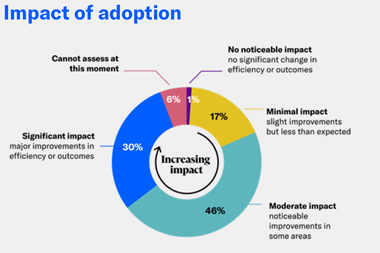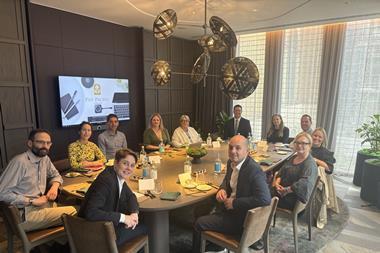Expert view: Against the backdrop of global supply chain disruption, geopolitical tension and escalating cyber threats, CROs must embrace centralised decision-making and enterprise risk management strategies. Global programmes can help, says AXA XL’s Ms Shiwei Jin
In association with AXA XL
This year, organisations have found themselves navigating a world in a state of perma- and poly-crisis.
Boardroom meetings have been dominated by threats, including global supply chain disruptions, trade uncertainties, escalating geopolitical tensions, and cyber risks.

Businesses in Asia have faced the added complication of severe natural disasters, including earthquakes, typhoons, floods and tsunamis. These inflict significant damage to facilities and infrastructure.
Climate change-related hazards, such as rising sea levels and extreme weather events, have the potential to amplify the frequency and severity of these events. The growing number and scale of threats on the horizon mean risk managers must take a holistic enterprise risk management approach.
Ms Shiwei Jin, head of global programmes, APAC & Europe, at AXA XL, explains: “In the past, corporate risk management primarily centred around a limited number of well-defined risks, largely focusing on financial aspects.
“The current landscape demands a broader scope of risk management; one that emphasises resilience. This comprehensive approach is now interwoven into the strategic development of top organisations, enabling companies to navigate a very dynamic operating environment.”
How international programmes can help
At its heart, a global programme solution requires a centralised risk management approach, something that aligns well with the ERM philosophy. However, to be successful, risk managers need to ensure that this approach is designed with the right goals in mind.
Jin says: “Identify areas where flexibility is required and opportunities to reduce costs. Analyse the business outlook and define the desired achievements in commercial terms.
”Risk professionals must then translate these factors into a comprehensive risk profile. Determine the most substantial risk and pinpoint the most risk-sensitive areas.”
This allows risk managers to refine their ERM strategies, introducing elements such as globally coordinated risk engineering and coverage options for worldwide operations.
The risk profile can also be used to refine master policy wordings, tailor local coverage, set appropriate limits or premiums, and address claims requirements.
”At its heart, a global programme solution requires a centralised risk management approach, something that aligns well with the ERM philosophy.”
Jin says: “Given the evolving and challenging risk landscape, attaining the right global programme solution holds even greater significance, both in terms of structure and implementation.
“This ensures the good management of established risks, providing effective coverage with the anticipated transparency, certainty and consistency.”
Other key benefits include cultivating a uniform risk management culture and process throughout the organisation, ensuring a robust insurance solution for international expansion, and effectively mitigating currency risks.
Jin adds that through risk engineering services, due diligence and insightful claims trend analysis, businesses using global programmes can pinpoint vulnerabilities in their operations.
This allows risk managers to implement targeted risk mitigation measures and enhance protocols while aligning with premium structures in compliance with local tariff or rate stipulations.
“Through risk engineering services, due diligence and insightful claims trend analysis, businesses using global programmes can pinpoint vulnerabilities in their operations.”
Global programmes can also help multinationals manage their currency exposure, a risk that has amplified macroeconomic challenges such as hyperinflation.
For instance, Sri Lanka experienced severe political and economic turmoil, including depleted foreign currency reserves during the first half of 2022. Many businesses struggled to make USD payments and needed to settle premiums in the local currency (LKR).
However, having the local policy denominated in the same currency as the local premium introduces currency risk. To help solve this challenge, AXA XL, in collaboration with local partners, allows clients to navigate currency risks via Central Premium Payment.
This tool, permitted by Sri Lanka on a net settlement basis, facilitates the remittance of local retained premiums, taxes and fees exclusively.
Best practice
Global programmes can add value to a wide range of organisations.
For instance, collaborative efforts between businesses, insurers and brokers span diverse sectors from global port operators and regional real estate investors to worldwide telecom providers and restaurant chains.
However, these programmes work best for industries or risks that need a worldwide approach. Jin gives the example of manufacturers engaged in cross-border sales.
She says: “Consider manufacturers with concentrated production sites in select countries, which in turn supply distribution centres in other countries. The business interruption losses suffered by these distribution centres often trace back to physical damage at manufacturing sites.
”These measures ensure compliant claims can be made, provide coverage for business interruption losses, and offer adequate master coverage”
”Determining how to assess and report business interruption value, as well as selecting the appropriate country for reporting such values and designing clauses relevant to this risk profile, becomes essential.
”To address such complexities, contingent business interruption clauses in related local countries and worldwide interdependency clauses under master policies are employed.
”These measures ensure compliant claims can be made, provide coverage for business interruption losses, and offer adequate master coverage considering differences in limits and conditions.”
Addressing local challenges
Generally, one of the benefits of international programmes is that they can be tailored for certain risks.
Typically, this is achieved by adopting strong local policies and adapting and enhancing them through a master policy. However, this can prove challenging when local policies are weak.
Jin explains: “This approach might prove insufficient for certain industries like luxury goods, port operations or commodity trading, where local standards fall short in providing essential coverage.
“In such cases, a full manuscript wording or bespoke endorsements could be imperative for programme-wide implementation, adhering to legal allowances, market practices and legislative contexts.
”This entails navigating local regulations, market norms and resources to achieve compliance while upholding transparency, centralised control and contractual certainty.”
When manuscript wordings are necessary, risk managers must carry out a localised analysis to:
- Ascertain the feasibility of the manuscript wording in the given jurisdiction, considering details such as the inclusion of terrorism coverage that might require a stand-alone policy in certain markets.
- Identify potential additional underwriting information or requirements, even when a robust local standard policy doesn’t necessitate them.
- Gain awareness of regulatory implications, including translation into local languages, legal reviews to ensure mandated clauses are incorporated, and potential regulatory filings or approvals. Examples include Latin American countries requiring policies in local languages, or South Korea and Egypt mandating local language filings for wordings and endorsements.
Building for success
The success of any global programme hinges on a collaborative three-way relationship involving clients, brokers and insurers.
In today’s landscape of increasing regulatory scrutiny and ever-shifting macroeconomic conditions, the management of global programmes can prove time-consuming if not executed with precision.
A global programme, if mishandled, can swiftly transform into a global predicament.
”Clear, timely and coordinated communication regarding the ‘what’, ‘how’, and ‘when’ is indispensable.”
Jin concludes: “I often liken a global programme to a dragon boat: a seamless performance requires the entire team to share a clear objective, maintain coordinated communication, and adhere to a well-defined timeline featuring agreed-upon action points among all three parties.
“Effective communication is essential. From the collection of risk information and programme design, right through to the final information upon programme binding, instructions, documentation implementation status, premium payment and claims handling – clear, timely and coordinated communication regarding the ‘what’, ‘how’, and ‘when’ is indispensable.”
Ms Shiwei Jin is head of global programmes, APAC & Europe, at AXA XL.














No comments yet